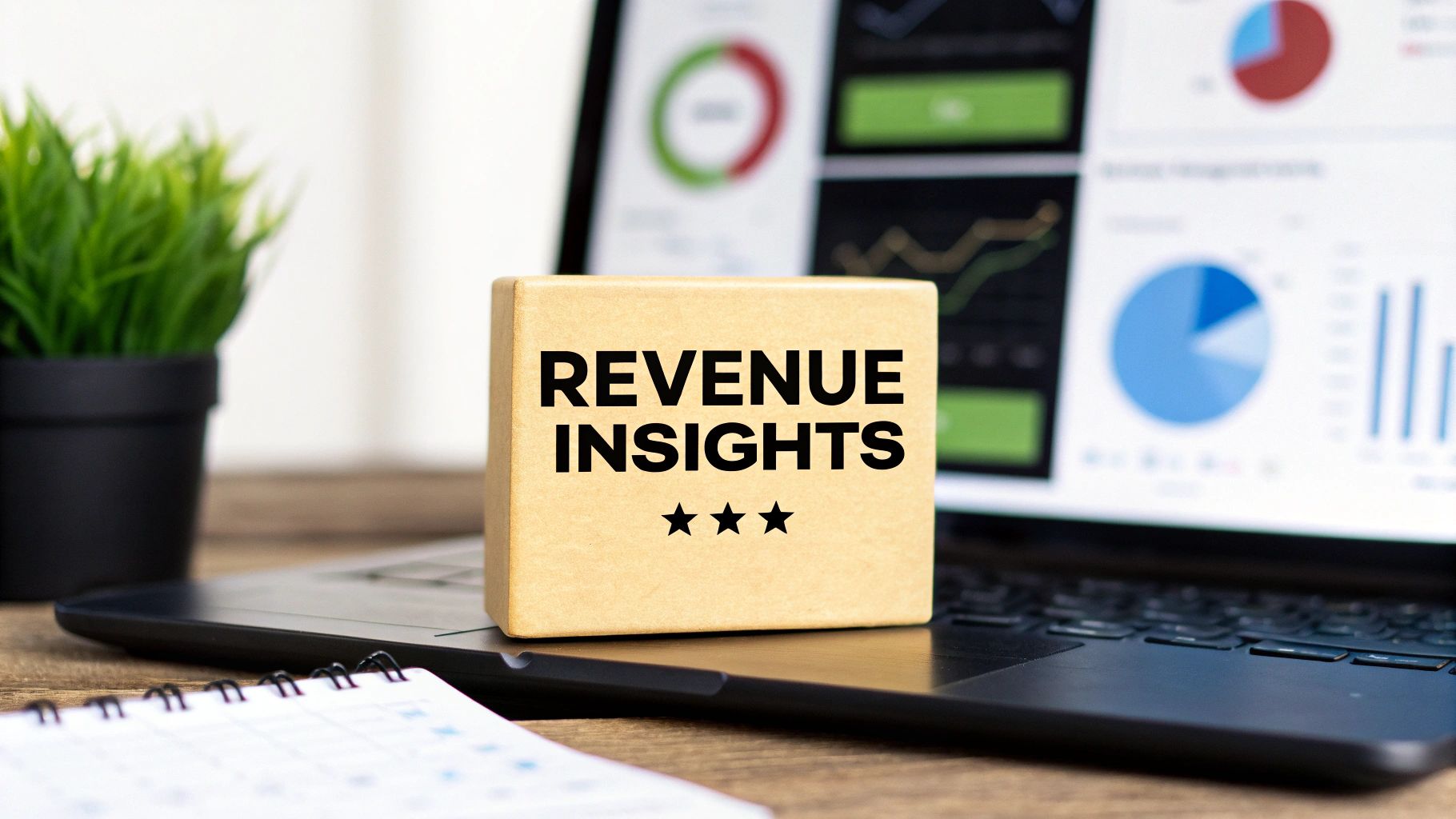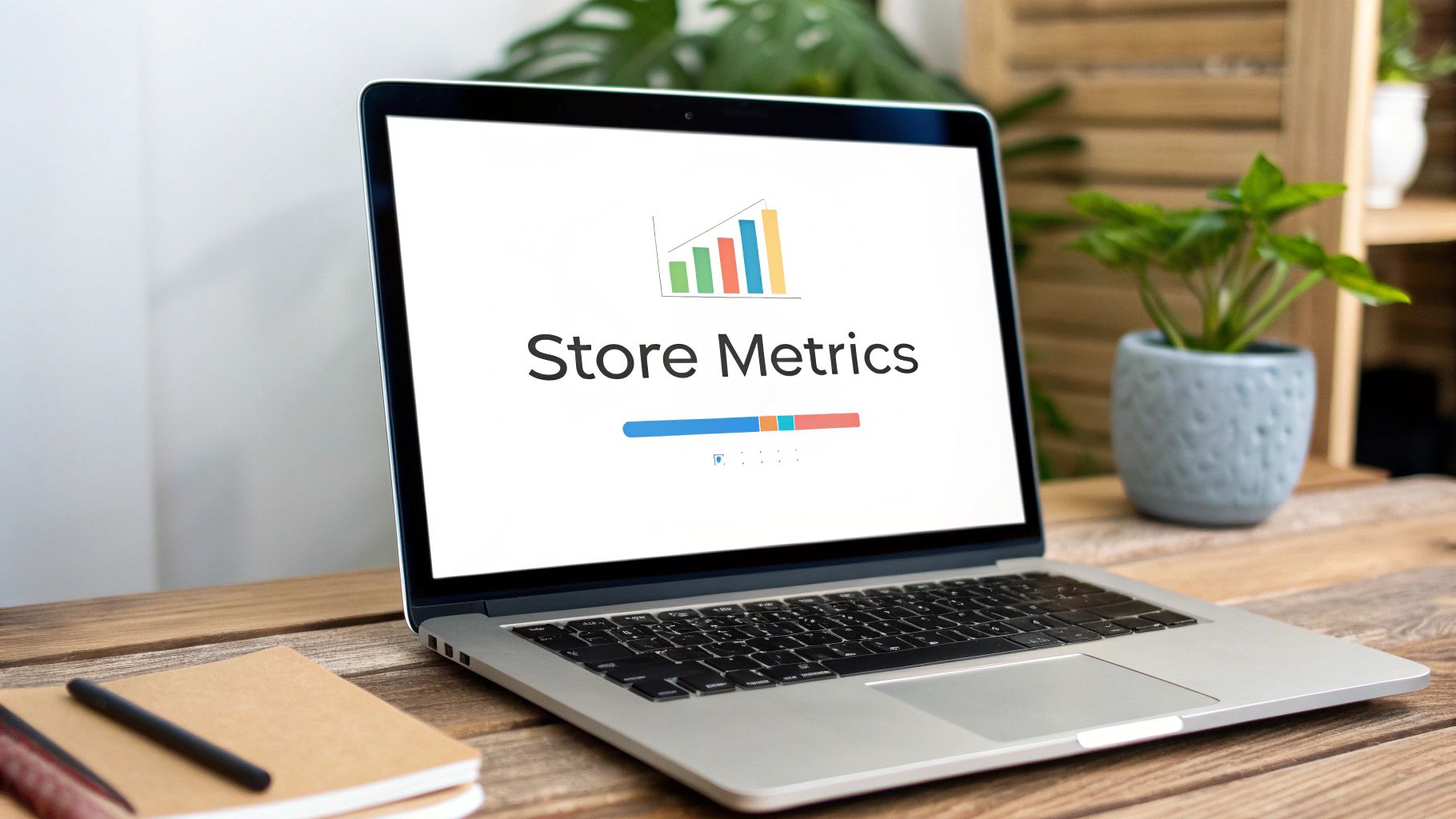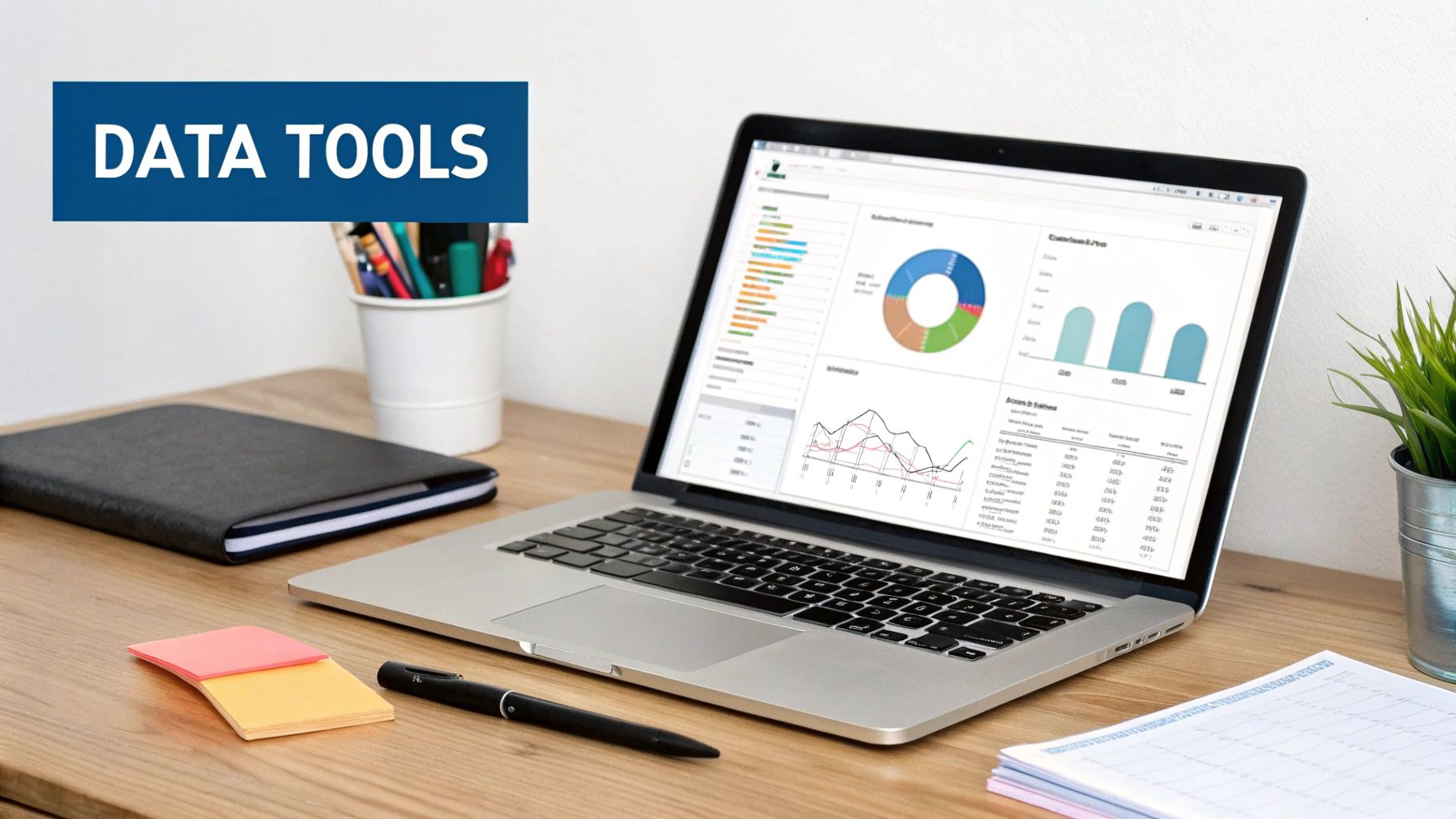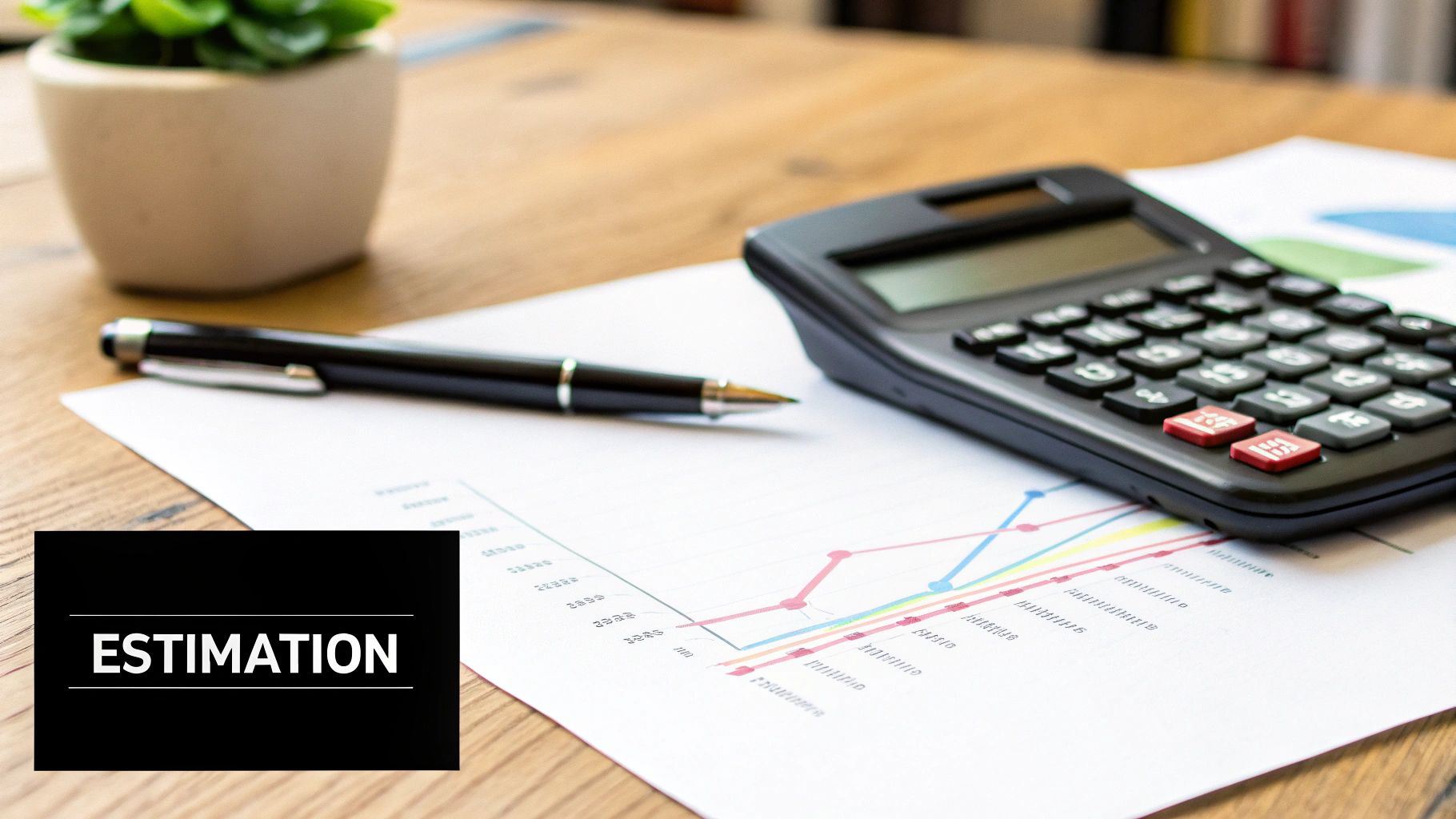How to See How Much a Shopify Store Makes – A Quick Guide
April 27, 2025

Cracking the Code: Shopify Revenue Fundamentals

Figuring out how much a Shopify store earns isn't straightforward. It's not like checking a company's public records. There's more to it than meets the eye. You need to look at what's visible and make informed estimates. While you can't see a store's exact profit, understanding how Shopify revenue works can tell you a lot.
There's a key difference between gross sales and net profit. Gross sales is the total value of everything sold. Net profit is what's left after expenses. Knowing this difference is essential for assessing a store’s financial health.
Decoding the Revenue Puzzle
Successful Shopify store owners know profit isn’t just about sales volume. It's about getting several things right. This includes marketing, customer service, inventory management, and pricing. Just looking at total sales can be misleading. For a deeper dive into the advantages of using Shopify, check out this article: How Shopify Benefits Your Online Business.
To get a good estimate of a store’s earnings, consider what makes up their revenue. Do they sell expensive items with higher profit margins? Or do they sell lots of items with smaller profits on each one? The business model matters too. A dropshipping store has different profit margins than a store selling its own products. Understanding this helps you see the real earning potential.
Shopify itself doesn't share how much individual stores earn. But looking at bigger trends can be helpful. Shopify’s total revenue in 2023 was about $7.06 billion, up from $5.6 billion in 2022. This growth shows more merchants are using the platform and selling more products, giving us a helpful benchmark. You can find more detailed Shopify statistics here. Estimating an individual store's earnings requires a closer look at their specific niche and how they operate.
To help understand the different ways Shopify generates revenue, let's take a look at the following table. It breaks down the various components and their significance in estimating a store's performance.
Shopify Revenue Components
Breakdown of Shopify's revenue sources to understand the ecosystem
| Revenue Source | Description | Relevance to Store Estimation |
|---|---|---|
| Subscription Solutions | Monthly fees paid by merchants for using the Shopify platform. | Provides a baseline understanding of the store's commitment to the platform. |
| Merchant Solutions | Fees generated from transactions, payment processing, and other services. | Directly correlates with the store's sales volume and transaction activity. |
| Apps and Themes | Revenue generated from sales of add-ons and design templates. | Indicates the store's investment in enhancing functionality and appearance. |
This table highlights the interconnectedness of Shopify's revenue streams and how they reflect the activity and investment of individual stores. Understanding these components allows for a more nuanced estimation of a store's performance beyond just looking at sales figures.
Key Factors Influencing Shopify Store Revenue
Even within the same niche, Shopify stores can have very different revenues. Why? Several things play a role. Good marketing strategies can boost sales. Optimized pricing and choosing the right products affect profit margins. A strong brand identity and great customer service can build customer loyalty, leading to repeat purchases and higher customer lifetime value. Recognizing these factors helps spot truly successful stores. It also helps separate them from those that just appear successful.
Unlocking Public Data for Revenue Insights

While getting exact revenue figures for a Shopify store requires internal access, publicly available data can offer valuable clues. With a little detective work, you can gain a surprisingly accurate understanding of a store's financial performance. Analyzing these clues reveals valuable insights into how much a Shopify store might be making.
Deciphering Product Listings and Customer Engagement
Analysts use several techniques to uncover revenue insights. Examining product listings, for example, offers a glimpse into potential earnings. Look at the number of products, their prices, and the perceived quality.
Customer reviews also provide important information. A high volume of positive reviews can suggest strong sales and customer satisfaction. This combination of product details and customer feedback offers a solid starting point for estimations.
Social media engagement provides further clues. A large and active following on platforms like Instagram and Facebook often correlates with higher brand visibility and potential revenue.
However, it's essential to distinguish between organic engagement and purchased followers or likes. Authentic engagement is a much stronger indicator of genuine customer interest and potential revenue.
Shopify merchants generate substantial and growing revenue. In 2024, they reached a record high of $11.5 billion in sales. Shopify itself generated $5.22 billion from merchant solutions in 2023, including transaction fees and payment processing revenues. This points to a thriving ecosystem. You can find more detailed statistics here. Keep in mind, though, that individual store earnings can vary significantly.
Spotting High-Volume Sellers vs. Struggling Stores
Analyzing data within Shopify is crucial for understanding a store's revenue fundamentals. Resources like the Shopify Analytics Dashboard provide guidance for data-driven decisions. By studying various data points, you can begin to differentiate between successful and struggling stores.
High-volume sellers often have extensive product catalogs, frequent updates, and robust customer service. Conversely, stores with limited inventory, outdated websites, and poor customer reviews may struggle to generate substantial revenue.
Tracking seasonal patterns and growth trajectories is another important aspect of this analysis. A sudden sales spike during a holiday season could indicate a reliance on seasonal trends. Consistent growth over time, however, suggests a more sustainable business model. Considering these diverse data points helps create a complete understanding of a Shopify store's potential earnings. This allows for more informed judgments about a store’s financial health and prospects.
Advanced Tools That Reveal Shopify Success Stories

Want to know the secrets behind successful Shopify stores? Going beyond basic observations, specialized ecommerce intelligence tools can provide deeper insights into their revenue. These tools offer a much more comprehensive view than simply looking at publicly available data. Let's explore some leading platforms and how they can help you unlock these Shopify success stories.
Unveiling Revenue With SimilarWeb, Jungle Scout, and Commerce Inspector
Tools like SimilarWeb, Jungle Scout, and Commerce Inspector offer valuable data for understanding a Shopify store's revenue. SimilarWeb excels at providing website traffic data, showing how many visitors a store attracts and their origins. This information is key for estimating potential sales.
Jungle Scout, initially designed for Amazon sellers, now offers insights into Shopify stores, focusing on product research and competitor analysis. Commerce Inspector specializes in uncovering product trends, best-sellers, and the advertising strategies used by successful Shopify businesses. Each tool brings unique perspectives to the table.
What These Tools Can Reveal
Each tool offers a unique set of features designed to give you a better understanding of a Shopify store’s revenue.
-
Traffic Analysis: Knowing where a store’s traffic originates (like social media or search engines) helps you evaluate the effectiveness of their marketing strategies.
-
Sales Estimations: Some tools provide estimated sales figures based on various factors, including traffic, average order value, and conversion rates.
-
Product Performance: Knowing which products are top sellers and their price points offers valuable clues about a store's overall revenue.
-
Advertising Strategies: Analyzing a store's ad spending and campaign effectiveness can reveal their financial investments and potential ROI.
Interpreting Tool-Generated Reports and Metrics
Understanding how these tools calculate their estimations is crucial. It’s also important to know which metrics are the most reliable. For example, traffic estimates are generally more accurate than revenue estimations, which often rely on algorithms and industry averages. Looking at key performance indicators (KPIs) like conversion rates, average order value, and customer lifetime value helps paint a fuller picture of a store’s financial health. Remember, estimations are informed approximations, not exact figures. For tips on improving your own Shopify sales, check out our article on how to increase sales on Shopify.
Balancing Budget with Free and Paid Tool Usage
While paid tools offer comprehensive data, free alternatives and strategic usage can also provide valuable insights. Free versions of tools like SimilarWeb offer basic traffic data. Google Chrome extensions can reveal details about a store's apps and technologies, hinting at their business investments.
Combining free resources with strategically chosen paid tools gives you access to powerful data without breaking the bank. You might use a free tool for a general overview of a store’s traffic, then invest in a paid tool for granular data on specific competitors or product categories. This balanced approach maximizes your budget while providing valuable information.
To help you choose the right tool for your needs, take a look at this comparison table:
To help you understand the options available, we've put together a comparison of some popular revenue estimation tools:
Revenue Estimation Tool Comparison: Comparison of top tools for analyzing Shopify store revenue
| Tool Name | Key Features | Price Range | Accuracy Rating | Best For |
|---|---|---|---|---|
| SimilarWeb | Traffic analysis, competitor benchmarking | Free & Paid (from $199/month) | High for traffic, moderate for revenue | Market research, competitive analysis |
| Jungle Scout | Product research, competitor tracking, sales estimations | Paid (from $49/month) | Moderate for sales, high for product trends | Product-focused businesses, Amazon sellers expanding to Shopify |
| Commerce Inspector | Product analysis, ad tracking, best-seller identification | Paid (from $99/month) | Moderate | Competitive analysis, product research |
This table summarizes the key features, pricing, and accuracy of each tool. For more advanced strategies to boost your Shopify sales, see our guide on how to master boosting Shopify Sales further. Carefully evaluate each tool to choose the best fit for your needs and budget. By understanding the strengths and limitations of these tools, you’ll be well-equipped to analyze the financial performance of Shopify stores.
Traffic-to-Revenue: The Conversion Mathematics

Traffic data is essential for estimating a Shopify store's revenue. Raw visitor numbers don't give the complete picture, though. This section explores how to translate traffic into realistic revenue figures using conversion mathematics, which involves understanding the relationship between visitors and buyers.
Calculating Probable Conversion Rates
Think of website traffic like a funnel. Not all the water poured in will reach the bottom. The percentage of visitors who become paying customers is the conversion rate. This rate varies depending on a few key factors.
-
Store Type: A niche store focusing on a specific audience might have a higher conversion rate than a general store.
-
Product Category: Popular products often convert better than niche items.
-
Price Point: Lower-priced items usually see higher conversion rates than luxury goods.
For example, a store selling phone accessories might have a higher conversion rate than one selling high-end jewelry. This is because phone accessories have a lower price point and a broader appeal. Understanding these nuances helps create more accurate revenue estimates. For tips on increasing traffic, check out our guide on driving traffic to your Shopify store.
Identifying Traffic Quality Indicators
Not all website traffic is equal. Traffic quality refers to how likely a visitor is to buy something. Several factors contribute to traffic quality.
-
Source: Traffic from targeted ads is generally higher quality than traffic from organic social media posts.
-
Demographics: Visitors matching the store's target audience are more likely to convert into customers.
-
Behavior: Time spent on the site, pages visited, and interaction with product pages all signal buying intent.
A visitor browsing multiple product pages for 10 minutes is a more promising lead than someone who leaves after 5 seconds. Recognizing these quality indicators allows for better revenue projections. This leads to more accurate and useful estimations.
Spotting Trends and Growth Patterns
Analyzing traffic trends helps you understand a store's performance. Seasonal trends, with sales increasing during holidays or special events, are common in ecommerce. Studying these trends allows for more accurate predictions based on past data.
Consistent traffic growth indicates a healthy business. This is a positive sign of effective outreach to the target audience. However, sudden spikes may point to unsustainable growth driven by temporary promotions or short-lived viral trends. Understanding this difference is crucial for long-term planning.
Reading Between the Lines: Product and Pricing Signals
A Shopify store's product catalog and pricing strategy can tell you a lot about its revenue. Much like a detective piecing together clues, you can learn to interpret these signals to estimate a store's earnings. This involves understanding how pricing, product presentation, and inventory combine to create a financial picture.
Deciphering Pricing Strategies: High-Margin Vs. High-Volume
One key aspect to consider is the store's pricing strategy. Does it focus on high-margin products with fewer sales, or high-volume products with smaller profit margins per item?
A store selling handcrafted jewelry, for instance, likely uses a high-margin model. They sell fewer pieces, but each sale generates a significant profit. On the other hand, a store selling inexpensive phone accessories probably relies on high volume. They sell many items at lower prices, accumulating profit through the sheer quantity of sales. Identifying the pricing model provides a base for understanding potential revenue.
Product Presentation: What Quality Reveals
Beyond pricing, how products are presented offers valuable clues. High-quality product photography, detailed descriptions, and a professional website design often correlate with higher revenue. These elements suggest investment in the online presence, reflecting a commitment to quality and customer experience.
Think of it like a physical storefront. A well-maintained and attractive store often indicates a successful business. You might find this helpful: How to master boosting your eCommerce sales. Furthermore, strong customer service indicators, like clear return policies and easy-to-find contact information, suggest a focus on customer satisfaction, potentially leading to more sales and repeat customers.
Inventory Clues: Decoding Stock Levels
The quantity and variety of products also provide insights. A large inventory with diverse product offerings might indicate a high-volume business model. A smaller, more curated selection might point to a focus on high-margin items.
For example, a store with thousands of different phone cases likely aims for high-volume sales. A boutique with a limited selection of handmade scarves likely focuses on higher profit margins per item. Observing inventory levels and variety adds another layer to understanding potential revenue.
Recognizing Revenue Stages
By analyzing these product and pricing signals, you can begin to recognize the characteristics of stores at different revenue stages. A startup might have a limited product selection, a simpler website, and lower prices.
A more established, higher-revenue store often features professional photography, detailed descriptions, a broader range of products, and possibly higher prices. These differences reflect the resources available at various growth stages. A seven-figure store usually demonstrates significant investment in product presentation, marketing, and customer service.
While determining the exact revenue remains difficult without internal data, these publicly visible details offer a good way to estimate a Shopify store’s financial performance.
Social Proof as a Revenue Window
Customer engagement provides valuable insights into a Shopify store's financial health. It's similar to a popularity contest: the more engagement a store receives, the more likely it's doing something right, often translating to higher revenue. This section explores how to interpret social proof, those crucial signals of customer approval, as indicators of revenue.
Review Patterns: Velocity, Sentiment, and Distribution
Reviews are a potent form of social proof. A large number of positive reviews typically suggests strong sales. However, it's not just the quantity that counts. Review velocity, the rate at which new reviews appear, shows the current sales momentum. A sudden increase in reviews could indicate a successful product launch or marketing campaign.
Sentiment analysis, which examines the overall tone of reviews, adds further context. While a high volume of reviews is positive, consistently positive sentiment is even better. It suggests not only strong sales but also customer satisfaction, leading to repeat business and increased customer lifetime value.
Finally, review distribution across various platforms paints a more complete picture. Are reviews mainly on the store's website, or are they also present on social media and third-party review sites like Trustpilot? Wider distribution suggests greater brand recognition and trust. You might also find our article on optimizing conversions on Shopify helpful.
Organic Vs. Purchased Engagement: Spotting the Difference
Social media metrics can be deceptive. A store may have thousands of followers, but if engagement is low, those numbers might not reflect genuine customer interest. It's important to differentiate between organic engagement and purchased engagement.
Organic engagement, such as genuine comments and shares, stems from real customer interaction and demonstrates authentic interest in the store’s products and brand. Purchased engagement, such as fake followers or bots, creates a false sense of popularity and offers little insight into actual revenue. Look for natural fluctuations in engagement metrics. Unusually consistent or suspiciously high engagement might point to purchased activity.
Tracking Social Media, Brand Mentions, and Community Interactions
Effective analysts look beyond vanity metrics like follower counts and track meaningful interactions, such as comments, shares, and brand mentions. These interactions provide a more accurate view of customer sentiment and brand awareness, both of which contribute to revenue. Brand mentions, specifically, reveal how frequently people are discussing a store, offering a valuable measure of brand visibility.
Active involvement in online communities related to the store's niche further suggests engaged customers and brand loyalty. This can involve participation in online forums, social media groups like those on Facebook, or even dedicated brand communities. These factors all contribute to a more comprehensive understanding of customer engagement and, consequently, potential revenue.
Assessing Email Subscriber Engagement and Loyalty Programs
Email marketing and loyalty programs offer further ways to evaluate revenue potential. High email open and click-through rates suggest an engaged subscriber base, which often leads to repeat purchases. Likewise, strong participation in loyalty programs demonstrates customer commitment and a higher probability of long-term revenue generation.
These recurring revenue streams are crucial for sustainable store growth and are often a more reliable indicator of long-term success than one-time purchases. By analyzing these diverse forms of social proof, you can gain a more insightful understanding of a Shopify store’s financial performance. This goes beyond simple sales figures and examines the underlying factors driving sustainable growth.
Ready to enhance your Shopify store's link-in-bio experience? Consider LinkShop, the ultimate link-in-bio tool specifically designed for Shopify merchants. Create attractive, shoppable link-in-bio pages that boost traffic and sales. It’s more powerful than Linkpop and seamlessly integrates with your Shopify store. Learn more about LinkShop.



